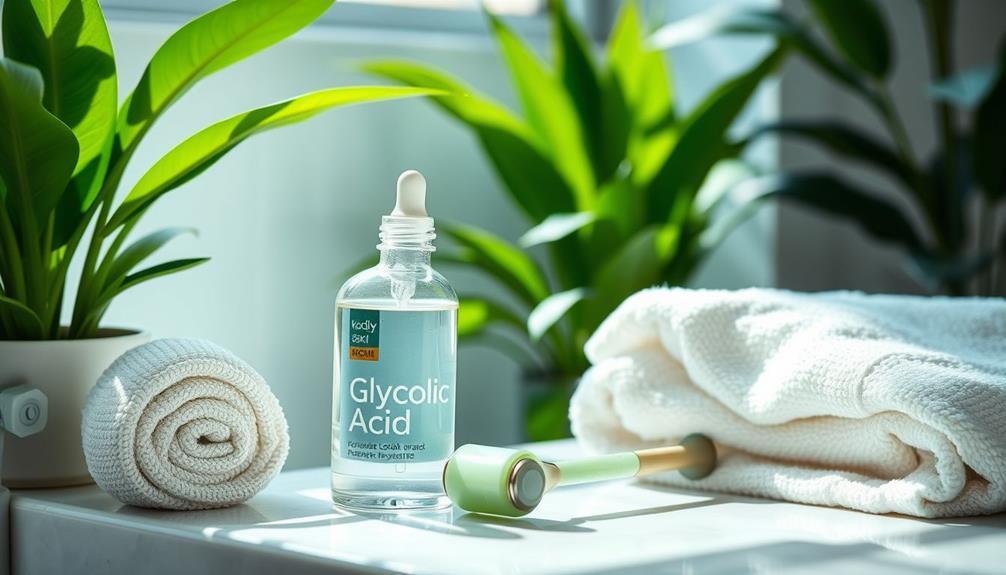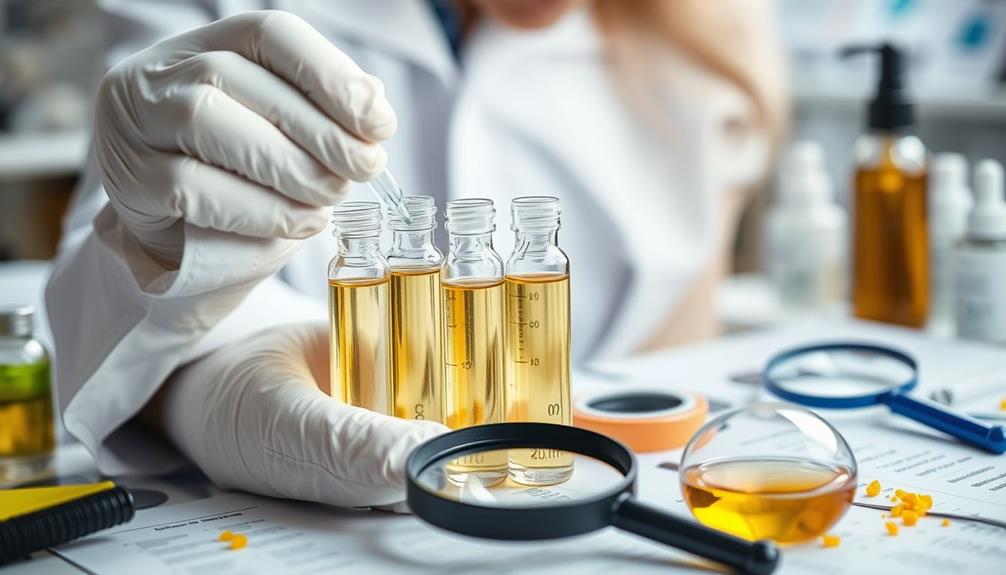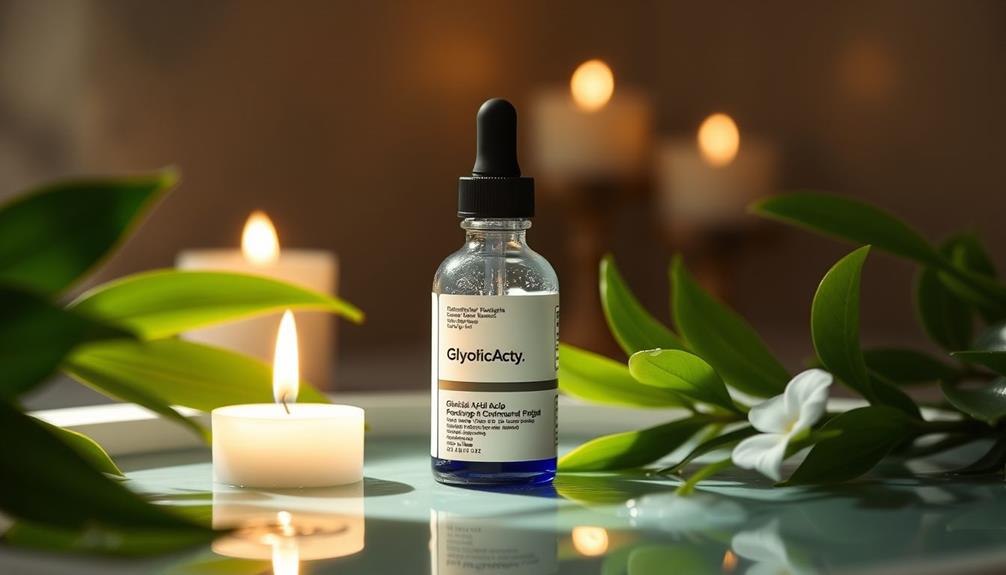Glycolic acid is a must-have in your skincare routine because it exfoliates effectively, revealing a brighter, smoother complexion. As the smallest alpha-hydroxy acid, it penetrates deeply, loosening dead skin cells and stimulating collagen production for firmer skin. You'll notice reduced fine lines, improved texture, and a boost in radiance. It's also great for treating acne by keeping your pores clear. Just remember to start with a lower concentration to avoid irritation and always use sunscreen, as it can increase sun sensitivity. Want to discover how to best incorporate it into your daily routine?
Key Takeaways
- Promotes powerful exfoliation by dissolving dead skin cells, revealing a smoother and more radiant complexion.
- Stimulates collagen production, enhancing skin elasticity and reducing the appearance of fine lines and wrinkles.
- Effectively clears clogged pores, making it a beneficial treatment for acne-prone skin.
- Acts as a humectant, attracting moisture to keep the skin hydrated and improve overall radiance.
What Is Glycolic Acid?

Glycolic acid, derived from sugar cane, is a powerful alpha-hydroxy acid (AHA) known for its exceptional ability to exfoliate and rejuvenate your skin.
It's the smallest AHA, which means it penetrates deeper into the skin compared to other acids, enhancing its effectiveness in promoting skin renewal.
When you incorporate glycolic acid into your skincare routine, you're actively loosening dead skin cells, leading to a smoother and more radiant complexion.
Additionally, the use of essential oils in your routine can further enhance skin health and relaxation.
Commonly found in various skincare products, glycolic acid not only exfoliates but also stimulates collagen production, which is vital for maintaining skin elasticity and reducing fine lines.
Its ability to improve skin texture and tone makes it a go-to solution for those struggling with acne, hyperpigmentation, and signs of aging.
Typically, you'll find glycolic acid in concentrations ranging from 5% to 30%.
It's wise to start with a lower concentration to gauge your skin's tolerance and minimize irritation.
Benefits of Glycolic Acid

You'll love how glycolic acid transforms your skin by providing powerful exfoliation and promoting a more youthful appearance. As an alpha-hydroxy acid, it effectively exfoliates by dissolving the bonds between dead skin cells, resulting in a smoother and brighter skin texture. This process not only enhances your complexion but also stimulates collagen production, helping to reduce the appearance of fine lines and wrinkles.
Additionally, incorporating essential oils for relaxation can complement your skincare routine by promoting a more balanced and serene state of mind.
Glycolic acid is particularly beneficial for those struggling with acne. It acts as an acne treatment by clearing clogged pores and preventing future breakouts, making it effective for various acne types. Additionally, its ability to improve skin radiance makes it a go-to ingredient for tackling signs of photoaging, like sun damage and uneven skin tone.
Moreover, regular use of glycolic acid can enhance hydration levels in your skin. As a humectant, it attracts and binds moisture, ensuring your skin stays plump and hydrated.
With all these benefits, incorporating glycolic acid into your skincare routine could be the key to revealing your best skin yet.
How Glycolic Acid Works

Glycolic acid works by exfoliating dead skin cells, which reveals a fresher complexion and promotes skin renewal.
This powerful ingredient can also help in addressing issues like uneven skin tone, much like how yoga for back pain management can provide targeted relief for discomfort.
It also stimulates collagen production, giving your skin a firmer and more elastic feel.
Plus, it attracts moisture, helping to keep your skin hydrated and clear.
Exfoliation and Skin Renewal
As the smallest alpha-hydroxy acid, glycolic acid penetrates deeply into the skin, effectively loosening the bonds between dead skin cells for ideal exfoliation. This process accelerates cell turnover, revealing fresher, more radiant skin underneath. Regular use of glycolic acid not only promotes skin renewal but also enhances overall texture and even skin tone, making it a powerful ally in your skincare routine.
Here's a quick overview of the benefits of glycolic acid:
| Benefit | Description |
|---|---|
| Exfoliation | Loosens dead skin cells for smoother skin. |
| Skin Renewal | Reveals fresher skin through increased cell turnover. |
| Acne Treatment | Clears clogged pores and prevents breakouts. |
| Even Skin Tone | Promotes a more uniform complexion. |
| Reduces Signs of Aging | Minimizes fine lines and wrinkles through hydration. |
Integrating glycolic acid into your regimen can greatly tackle signs of aging while providing effective acne treatment. Its exfoliating properties guarantee you're left with smoother skin and a brighter complexion, making it a must-have in your skincare arsenal.
Collagen Production Stimulation
When you incorporate glycolic acid into your skincare routine, it actively stimulates collagen production, enhancing your skin's firmness and elasticity. This powerful ingredient promotes fibroblast activity, which is essential for generating collagen.
As you use glycolic acid, it encourages skin cell turnover, effectively exfoliating the surface layers and allowing newer, collagen-rich skin to emerge. Additionally, maintaining a healthy weight is important for overall skin health, as obesity can lead to various skin issues cat weight chart by age.
Research shows that regular use of glycolic acid can greatly boost collagen levels, helping to reduce the appearance of fine lines and improve overall skin texture. This means your skin not only feels smoother but also looks more youthful.
By counteracting collagen breakdown caused by aging and sun exposure, glycolic acid serves as a formidable ally in your anti-aging arsenal.
Additionally, glycolic acid peels are particularly effective for skin rejuvenation, as they can enhance collagen synthesis even further.
With consistent application, you'll notice improved skin elasticity and a reduction in signs of aging, giving your complexion a fresher, revitalized appearance.
Embracing glycolic acid in your skincare routine can transform your skin, making it firmer, smoother, and more resilient.
Hydration and Skin Clarity
Harnessing its potent humectant properties, glycolic acid draws moisture into your skin, boosting hydration while enhancing overall clarity. This powerful ingredient works effectively to keep your skin hydrated and prevent dryness, making it essential for a healthy complexion.
Its exfoliating properties help remove dead skin cells, allowing your other hydrating skincare products to penetrate deeper and work more effectively. By stimulating cell turnover, glycolic acid promotes the regeneration of new skin, leading to a brighter, more even complexion.
Regular use can greatly improve skin texture, reducing the appearance of fine lines and uneven pigmentation. You'll notice your skin looks smoother and feels softer.
Moreover, glycolic acid can refine enlarged pores, resulting in a clearer skin surface. As you incorporate this ingredient into your routine, you'll likely see improvements in skin clarity and overall radiance.
With continued use, glycolic acid not only helps achieve hydration but also transforms your skin, making it a must-have in your skincare arsenal. Embrace the benefits of glycolic acid, and watch your skin flourish with enhanced hydration and clarity.
Application Guidelines

To guarantee safe and effective use of glycolic acid, start with lower concentrations and gradually increase as your skin adapts. This is especially important if you have sensitive skin, as it helps minimize irritation.
Here are some application guidelines to follow:
- Begin with a patch test: Always conduct a patch test on a small area of skin before full application to check for any adverse reactions. This is essential for sensitive skin types.
- Monitor your frequency: Start by applying glycolic acid products three times per week. Pay attention to how your skin responds, and adjust the frequency based on your tolerance. If you tolerate it well, you can work your way up to daily use.
- Use sunscreen daily: Since glycolic acid can increase sun sensitivity, apply it at night and always follow up with a broad-spectrum sunscreen during the day.
Avoid using glycolic acid alongside retinoids or other strong exfoliants, as this can lead to excessive irritation.
Risks and Side Effects

When using glycolic acid, you might face skin irritation, such as redness and peeling, especially if you have sensitive skin.
It's also essential to be aware that glycolic acid can increase your sun sensitivity, so applying sunscreen daily is a must.
To minimize side effects, start with lower concentrations and pay attention to how your skin reacts.
Skin Irritation Potential
Glycolic acid can lead to skin irritation, especially for those with sensitive skin or higher concentrations, manifesting as redness, itching, and burning. To minimize risks, consider these vital steps:
- Patch Test: Always conduct a patch test before full application. This helps you gauge your skin's sensitivity and tolerance to glycolic acid.
- Start Low: Begin with lower concentrations (under 10%) to reduce the chances of adverse reactions. Gradually increase the concentration as your skin adjusts.
- Monitor Continuous Exposure: Be aware that continuous exposure can increase your skin's vulnerability to irritation and potential sun damage.
If you experience persistent skin irritation, it's best to discontinue use and consult a dermatologist. Some users might also experience a "purging" phase, where existing acne worsens temporarily before improving due to increased cell turnover.
Remember to listen to your skin; if you notice significant discomfort or signs of adverse reactions, adjusting your regimen is essential. By following these guidelines, you can enjoy the benefits of glycolic acid while minimizing risks.
Sun Sensitivity Concerns
Using glycolic acid can markedly increase your skin's sensitivity to sunlight, elevating the risk of sunburn and pigmentation issues.
This heightened sun sensitivity is particularly concerning when you're exposed to UV radiation, as it can lead to significant side effects.
If you're using glycolic acid, it's vital to apply a broad-spectrum sunscreen daily to protect your skin.
Studies show that individuals with sensitive skin or those using higher concentrations of glycolic acid are at an even greater risk of sunburn.
Without proper sun protection, you might experience skin irritation, redness, and exacerbated hyperpigmentation.
These effects can be frustrating, especially if you're using glycolic acid to improve your complexion.
To minimize these risks, consider applying glycolic acid skincare products at night.
This allows your skin to recover without the added stress of sun exposure.
Remember, regular use of glycolic acid without adequate sun protection can lead to long-term pigmentation issues.
Be proactive about your skincare routine—always layer on that sunscreen and monitor how your skin reacts to glycolic acid to guarantee you achieve the best results without compromising your skin's health.
Glycolic Acid for Scars

For those looking to improve the appearance of scars, glycolic acid offers a promising solution by lightening dark patches and promoting skin regeneration. This powerful ingredient works by exfoliating the skin's surface, softening the look of scars while addressing hyperpigmentation.
Here are three key benefits of using glycolic acid for scar treatment:
- Effective Exfoliation: Glycolic acid helps remove dead skin cells, revealing fresher skin underneath. This process can reduce the visibility of scars over time.
- Improved Scar Reduction: Professional glycolic acid peels utilize higher concentrations, providing more effective treatment for raised and pitted scars than over-the-counter products.
- Combination Treatments: Pairing glycolic acid with alternative therapies, like microneedling, can lead to even better scar reduction results.
While glycolic acid can considerably improve the appearance of scars, it's important to remember that it may not completely eliminate them.
For best results, consider incorporating alternative therapies alongside your glycolic acid regimen. Embracing this approach can lead to more noticeable improvements in your skin's texture and tone.
Choosing the Right Product

When you're choosing a glycolic acid product, it's essential to take into account both the type and concentration.
For sensitive skin, stick to lower concentrations around 5-10%, while more resilient skin can handle stronger options.
Understanding these factors will help you find the right product for your skincare goals.
Product Types Overview
Choosing the right glycolic acid product involves understanding the various forms available, such as cleansers, toners, serums, masks, and peels, each offering unique benefits for your skincare routine.
Here's a quick overview of the primary product forms to take into account:
- Cleansers: Great for daily exfoliation, these products typically contain lower concentrations of glycolic acid, making them suitable for all skin types.
- Toners: These help to balance your skin's pH and prep it for further treatment. Look for toners with hydrating ingredients to complement the exfoliating benefits of glycolic acid.
- Serums and Masks: Leave-on products often deliver more potent results due to prolonged contact with the skin. You can find higher concentrations in serums, but start slow to gauge your skin's response.
When selecting an over-the-counter product, it's crucial to take into account your skin type.
If you have sensitive or dry skin, opt for lower concentrations enriched with hydrating ingredients to improve tolerance.
Begin with a glycolic cleanser or serum, and adjust your usage frequency according to how your skin reacts.
Concentration Matters
Understanding the concentration of glycolic acid in products helps you select the right fit for your skin's needs and sensitivities. Glycolic acid concentrations in over-the-counter products typically range from 5% to 30%.
If you have sensitive skin, stick to lower concentrations of 5-10% to minimize irritation. For effective exfoliation and anti-aging benefits, products with 10-15% glycolic acid are often suitable, providing noticeable results without excessive irritation.
When choosing a product, don't overlook the pH level; aim for a pH around 4 for ideal skin compatibility and effectiveness. If you're new to glycolic acid, gradually introduce it into your skincare routine. Start with lower concentrations and increase frequency as your skin adjusts to prevent adverse reactions.
For those seeking deeper exfoliation, professional chemical peels can utilize glycolic acid concentrations of up to 70%. However, these should only be performed under the supervision of a qualified dermatologist.
Safe Usage Tips

To safely incorporate glycolic acid into your skincare routine, start with lower concentrations and gradually increase usage as your skin adjusts. This approach helps minimize irritation and allows you to build tolerance effectively. Here are some safe usage tips:
- Patch Test: Always conduct a patch test on a small area of skin before full application. This step is essential, especially if you have a history of skin sensitivities. It helps you check for any adverse reactions.
- Frequency: Begin by applying glycolic acid products three times a week. Monitor your skin's response and adjust the frequency as needed. This gradual introduction is key for those with mild to moderate skin types.
- Sun Sensitivity: Apply glycolic acid at night, as it can increase sun sensitivity. Always follow up your nighttime routine with a broad-spectrum sunscreen during the day to protect your skin.
Glycolic Acid in Your Routine

Incorporating glycolic acid into your routine can dramatically transform your skin by accelerating cell turnover and revealing a smoother, more radiant complexion.
By exfoliating dead skin cells, glycolic acid helps you achieve that fresh glow and enhances the overall effectiveness of your skin care products.
To get started, choose glycolic acid products with lower concentrations, around 5-10%. This allows you to assess your skin's tolerance before gradually increasing the frequency and potency.
You'll soon discover the benefits of glycolic acid, which include reducing the appearance of fine lines, wrinkles, and uneven skin tone. Regular use stimulates collagen production, considerably improving skin texture over time.
For ideal results, apply glycolic acid at night. Following your application, always use a broad-spectrum sunscreen during the day to protect your skin, as glycolic acid can increase sun sensitivity.
You'll find this ingredient in various forms, such as cleansers, serums, and peels, making it a versatile addition to any skincare regimen tailored to your individual needs.
Embrace the transformative power of glycolic acid and watch your skin flourish!
Research and Evidence

Research shows that glycolic acid delivers considerable benefits for skin health, supported by numerous clinical studies highlighting its effectiveness in improving texture, tone, and hydration.
Specifically, you can rely on glycolic acid for:
- Treating skin conditions: Its antibacterial properties make it ideal for acne-prone skin, effectively targeting breakouts and preventing new ones.
- Enhancing skin texture: Clinical studies indicate that 10% to 15% topical glycolic acid can noticeably improve skin clarity, resulting in a smoother, more radiant complexion.
- Combating photoaging effects: Research has demonstrated that glycolic acid peels considerably reduce signs of aging, including fine lines and uneven skin tone.
Moreover, studies show that combining glycolic acid with treatments like microneedling can enhance the management of atrophic acne scars.
For pigmentation disorders like melasma, a blend of tranexamic acid and glycolic acid has proven effective in accelerating improvement.
So, if you're looking to improve skin health and achieve a youthful appearance, incorporating glycolic acid into your skincare routine is a smart choice.
With its proven efficacy, you can trust it to deliver real results.
Conclusion
So, if you're still on the fence about glycolic acid, just imagine your skin throwing a tantrum, begging for some exfoliating love while you ignore it.
This powerhouse ingredient isn't just a trend; it's the key to a radiant complexion.
With its ability to reveal fresh skin beneath, skipping it would be like choosing to wear a winter coat in July.
Embrace the glow, and let glycolic acid work its magic—your skin will thank you!










